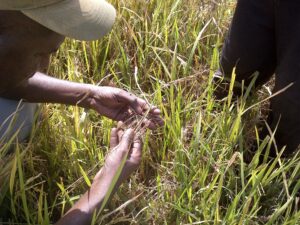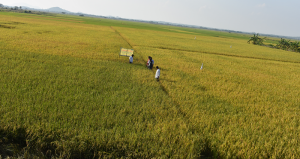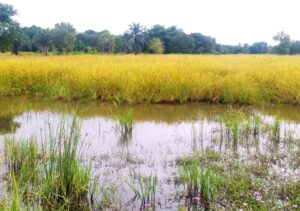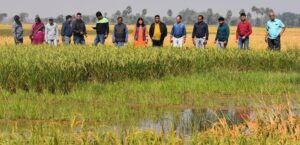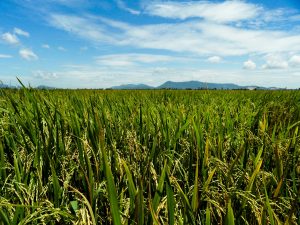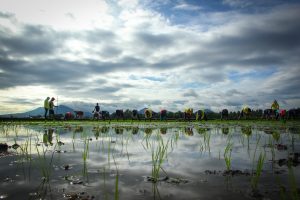
Prioritization of agricultural technology development—such as breeding for new varieties—should, among other things, be based on expectations about the adoption of the technology by farmers, and on the consequential economic and environmental benefits. That is easier said than done. A major obstacle to estimating adoption and benefits is that the value of agricultural technologies is location-specific. That is, their utility can depend strongly on spatially variable environmental factors, such as soil type and climate, and social and economic circumstances.
The effect of environmental variability on crop growth can to some extent be estimated with crop growth models. Such models encapsulate knowledge of eco-physiological processes and allow simulation of crop yield for specific varieties and locations. In this way, complex location data, such as daily weather data, can be summarized with an easy-to- interpret index such as crop yield.
The map shows the yield of rice grown in lowland conditions (flat, flooded fields) without irrigation relative to yield with full irrigation (we refer to this as the “relative yield”), as computed with the ORYZA2000 simulation model.1 For example, in red areas, rice grown without irrigation would achieve less than 15% of the yield expected with irrigation. It is a highly stylized example that shows simulation results for only one variety (IR72). It used 9 years of daily weather data to compute average and relative yields (with and without irrigation) over this period. Many other known sources of variation, such as local hydrological processes and differences in soil types, are not taken into account in this example.
It nevertheless shows some basic facts about rice and water. There are some places where you cannot grow much rice without irrigation. This does not necessarily mean that water stress is an important problem there. In fact, some of the most productive rice areas are found there, including the Punjab in India and the Nile Valley in Egypt. On the other hand, if water becomes scarce in these regions—as is happening in many areas—water-saving irrigation technologies and appropriate varieties would be very useful.
Most areas with a relative rice yield of below 50% have little rainfed (nonirrigated) rice production.3 But this does not mean there is no irrigated rice in wetter areas where farmers could produce a reasonable rice crop without irrigation. For example, in southeastern China, farmers could produce rice without irrigation. However, supplemental irrigation increases production, particularly in dry years, and allows for the production of rice or another crop outside the main rainy season.
The map shows the relation between maximum rainfed yield (in the rainy season) and yield of irrigated rice in the off-season (any season that would allow the highest yield if irrigation were available). It therefore reflects a yield increase partly by reduced water stress and partly by shifting toward growing seasons with more solar radiation and perhaps lower temperatures.
Drought tolerance would seem particularly relevant in areas with predominant rainfed production with a moderate to large yield reduction (50–70% relative yield). Such areas include Bangladesh and eastern India. Current research aims to refine the approach by improving the data used to run the models, and by running models for different rice ecosystems and for different varieties to contrast existing versus new drought- tolerant varieties, and to contrast current cropping practices versus water-saving technologies.
_________________________________________
Dr. Hijmans is a geographer in the IRRI Social Sciences Division.

